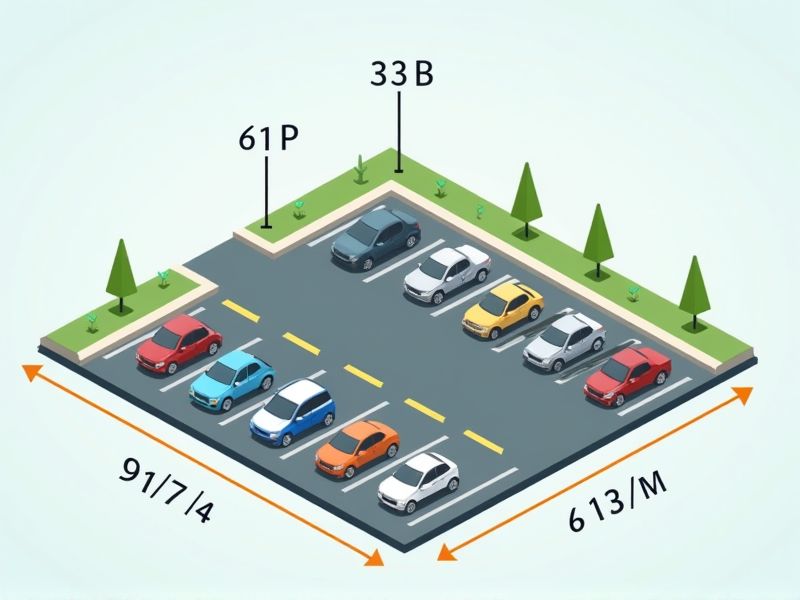
When designing a parking lot, understanding standard dimensions helps ensure efficient use of space and ease of vehicle maneuvering. Typically, individual parking spaces are about 9 feet wide by 18 feet long, which accommodates most passenger vehicles comfortably. Drive aisles, which allow cars to access parking spaces, are usually 24 feet wide for two-way traffic and 12 to 16 feet for one-way traffic. Knowing these measurements can help you plan a safe and functional parking layout, whether for a commercial project or personal property.
Parking Stall Width
The standard width for a parking stall is typically between 8.5 to 9 feet, accommodating most vehicles while ensuring ease of access. Regulations may vary by region, but many municipalities follow guidelines set by the American National Standards Institute (ANSI). In compact parking areas, stalls may be reduced to 7.5 feet wide, allowing for a higher density of vehicles. Proper stall width not only enhances user experience but also minimizes the risk of damage to vehicles and improves safety for pedestrians navigating the area.
Parking Stall Length
The standard parking stall length is typically 18 feet (5.5 meters), accommodating most vehicles comfortably. In commercial settings, such as malls and office complexes, a well-designed parking lot maximizes space efficiency while ensuring safety and accessibility. Variations may exist, with some jurisdictions providing regulations for compact stalls, often measuring 15 feet (4.6 meters) in length. Your parking lot design can greatly influence the flow of traffic and usability, making adherence to these standards essential for a functional layout.
Aisle Width
The recommended aisle width for parking lots typically ranges from 24 to 26 feet, which allows for the safe and efficient maneuvering of vehicles. Aisle dimensions directly impact traffic flow, with wider aisles facilitating easier access to parking spaces and reducing the likelihood of accidents. By adhering to these standards, you enhance the overall user experience, ensuring that drivers can navigate the area smoothly. Proper planning of aisle width not only maximizes space but also improves the safety and functionality of your parking lot.
Accessible Parking Space Dimensions
Accessible parking spaces must adhere to specific dimensions to ensure usability for individuals with disabilities. The standard size is typically 8 feet wide for the parking space, with an additional 5-foot access aisle. This design facilitates wheelchair users and those with mobility aids, allowing easy entry and exit from vehicles. Compliance with these measurements is crucial for businesses to meet ADA (Americans with Disabilities Act) requirements and promote inclusivity in their facilities.
Parking Lot Slope
The standard slope for a parking lot typically ranges from 1% to 5%, ensuring effective drainage and safety for vehicles. A 2% slope is commonly recommended, providing adequate runoff while minimizing vehicle strain. You should also consider features like wheel stops and curbing that can influence the overall design and slope functionality. Proper grading and adherence to slope standards can enhance usability and longevity, with some guidelines stipulating specific measures for accessibility compliance.
Minimum Clearance Height
The minimum clearance height in parking lots typically ranges from 7 to 8 feet, ensuring accessibility for most vehicles, including SUVs and vans. This standard is crucial, as insufficient clearance can lead to vehicle damage or safety hazards. For optimal safety and efficiency, it's advisable to check local regulations, as they may stipulate different requirements based on building codes. Proper signage marking the clearance height can significantly enhance the user experience, helping you avoid potential inconveniences.
Entry And Exit Lane Width
The minimum width for entry and exit lanes in parking lots typically ranges from 12 to 15 feet, ensuring smooth traffic flow and safety for both vehicles and pedestrians. Proper lane design is crucial, as inadequate widths can lead to congestion and accidents, impacting overall user experience. For larger vehicles, such as delivery trucks, a width of 20 feet may be necessary to facilitate easy access. By prioritizing these standards, you can enhance navigation and optimize the functionality of your parking space.
Curb Radii
Curb radii in parking lots significantly influence vehicle maneuverability and safety, with recommended radii typically ranging from 15 to 25 feet for efficient navigation. A larger curb radius reduces the risk of collisions and ensures smoother turns, benefiting both pedestrians and drivers. Implementing proper curb radii can also affect the overall design of the parking lot, offering improved traffic flow and space optimization. If you're planning a parking lot layout, consider these dimensions to enhance usability and compliance with safety standards.
Compact Car Space Dimensions
Compact car space dimensions typically measure 8 to 10 feet in width and 15 to 18 feet in length, making them ideal for vehicles that are shorter and narrower than standard-sized cars. In urban areas, where space is limited, these designations can increase parking efficiency, allowing for more vehicles to fit within the same area. According to the American National Standards Institute (ANSI), proper compact space dimensions not only enhance parking convenience but also ensure compliance with accessibility standards. When parking in compact spaces, you should be mindful of your vehicle's size to maximize convenience and minimize the risk of dings or damage.
Loading Zone Dimensions
Loading zones are essential components of parking lot design, typically measuring 10 to 20 feet wide and 20 to 30 feet long, accommodating safe and efficient loading and unloading activities. Municipal regulations often specify the required dimensions to ensure accessibility for commercial vehicles and compliance with ADA standards. Marking these zones clearly with signage and paint helps manage traffic flow, reducing congestion and potential accidents. You should consider local zoning laws that may dictate specific requirements for your loading areas.
